 Advances in Linear Algebra & Matrix Theory, 2011, 1, 1-7 doi:10.4236/alamt.2011.11001 Published Online December 2011 (http://www.SciRP.org/journal/alamt) On Real Matrices to Least-Squares g-Inverse and Minimum Norm g-Inverse of Quaternion Matrices* Huasheng Zhang School of Mathematics Science, Liaocheng University, Shandong, China Email: zhsh0510@yahoo.com.cn Received November 20, 2011; revised December 24, 2011; accepted December 30, 2011 ABSTRACT Through the real representations of quaternion matrices and matrix rank method, we give the expression of the real ma- trices in least-squares g-inverse and minimum norm g-inverse. From these formulas, we derive the extreme ranks of the real matrices. As applications, we establish necessary and sufficient conditions for some special least-squares g-inverse and minimum norm g-inverse. Keywords: Extreme Rank; g-Inverse; Least-Squares g-Inverse; Minimum Norm g-Inverse; Quaternion Matrix 1. Introduction Throughout this paper, stands for the real number field, stands for the set of all m matrices over the quaternion algebra mn n 222 01 23 0123 === ,,,. aa iajakijkijk aaaa ==1, I, AT, A* and † stand for the identity matrix’ the transpose’ the conjugate transpose and the Moore-Pen- rose inverse of a quaternion matrix A. In [1], for a qua- ternion matrix A, m= dim.di A dim † is called the rank of a quaternion matrix A and denoted by .rA The well known Moore-Penrose inverse of mn is defined to be the unique matrix mn satisfying the following four Penrose equations 1) =, XAA 2) =, AXX 3) =, XAX =. 4) AXA A matrix X is called a least-squares g-inverse of A if it satisfies both 1) and 3) in the Penrose equations, and de- noted by a matrix X is called a minimum norm g-inverse of A if it satisfies both 1) and 4) in the Penrose equations, and denoted by The general expres- sion of 1,3 ;A 1,3 1,4.A and 1,4 can be written as 1,3 † = A, ALV (1) 1,4† =A AWR (2) where , the two matrices V and W is a arbitrary; see [[2], pp. 44-46]. † =, A LIAA† = A RIAA For convenience of representation, we suppose 01 23 = AAiAjAk (3) and 1,3 01 23 1,40123 =, = BBiBjBk CCiCjCk (4) where 0123 ,,, , mn AAAA 0123 ,,, , mn BBBB 0123 ,,, . nm CCCC For an arbitrary qu aternion matrix 12 34 =, MMiMjMk we define a map () from to by mn 44mn 4321 34 12 21 43 1234 =. MMMM MM MM MMM MM MMMM (5) By (5), it is easy to verify that () satisfies the fo llow- ing properties: a) ==. NMN b) =, NMN =, NMN =,kMkM k . c) 11 == mnm n TMTRMR =, mn SMS 1 *This research was supported by the Natural Science Foundation of China (11001115). where C opyright © 2011 SciRes. ALAMT 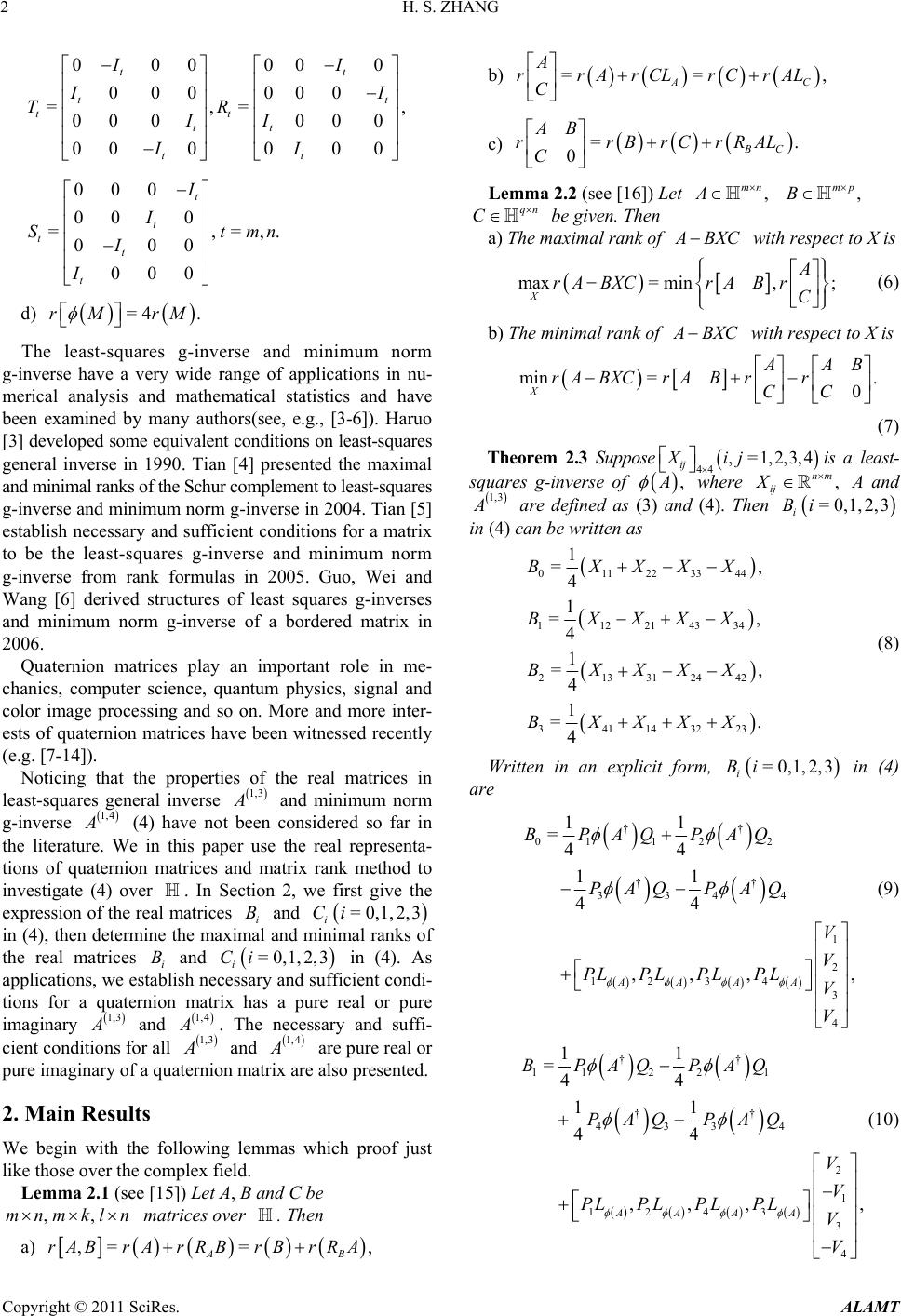 H. S. ZHANG 2 000000 000 000 =,=, 00 000 0 00000 0 000 00 0 =,=,. 000 000 tt tt tt tt tt t t tt t II I TR II II I I Stmn I I d) =4 .rM rM The least-squares g-inverse and minimum norm g-inverse have a very wide range of applications in nu- merical analysis and mathematical statistics and have been examined by many authors(see, e.g., [3-6]). Haruo [3] developed some equivalent conditions on least-squares general inverse in 1990. Tian [4] presented the maximal and minimal ranks of the Schur complement to least-squares g-inverse and minimum norm g-inverse in 2004. Tian [5] establish necessary and sufficient conditions for a matrix to be the least-squares g-inverse and minimum norm g-inverse from rank formulas in 2005. Guo, Wei and Wang [6] derived structures of least squares g-inverses and minimum norm g-inverse of a bordered matrix in 2006. Quaternion matrices play an important role in me- chanics, computer science, quantum physics, signal and color image processing and so on. More and more inter- ests of quaternion matrices have been witnessed recently (e.g. [7-14] ) . Noticing that the properties of the real matrices in least-squares general inverse 1,3 and minimum norm g-inverse 1,4 (4) have not been considered so far in the literature. We in this paper use the real representa- tions of quaternion matrices and matrix rank method to investigate (4) over . In Section 2, we first give the expression of the real matrices i and in (4), then determine the maximal and minimal ranks of the real matrices i and i in (4). As applications, we establish necessary and sufficient condi- tions for a quaternion matrix has a pure real or pure imaginary B B =0Ci =0,1,2,3 i Ci 2,3 ,1, 1,3 and 1,4 . The necessary and suffi- cient conditions for all 1, 3 and 1,4 are pure real or pure imaginary of a quaternion matrix are also presented. 2. Main Results We begin with the following lemmas which proof just like those over the complex field. Lemma 2.1 (see [15]) Let A, B and C be matrices over . Then ,,mnmkln a) ,= = AB rABrArRBrBrRA, , L b) == AC A rrArCLrCrAL C c) =. 0BC AB rrBrCrRA C Lemma 2.2 (see [16]) Let , mn A , mp B qn C be given. Then a) The maximal rank of BXC with respect to X is max= min,; X A rABXCrAB rC (6) b) The minimal rank of BXC with respect to X is min =. 0 X AB rA BXCrABrr CC (7) Theorem 2.3 Suppose is a least- , =1,2,3,4 ij Xij 44 squares g-inverse of , where ij A and , nm X 1,3 are defined as (3 ) and (4). Then in (4) can be written as 1,2,3 =0, i Bi 0 11223344 1 12214334 21331244 34114322 1 =, 4 1 =, 4 1 =, 4 1 =. 4 BXXXX BXXXX B XXXX BXXXX 2 3 (8) Written in an explicit form, in (4) are =0,1,2,3 i Bi †† 01 122 †† 3344 1 2 12343 4 11 =44 11 44 ,,,, AAAA BPAQPAQ PAQ PAQ V V PL PL PL PLV V (9) †† 11 22 1 †† 4334 2 1 1243 3 4 11 =44 11 44 ,,,, AAAA BPAQPAQ PAQ PAQ V V PL PL PL PLV V (10) Copyright © 2011 SciRes. ALAMT 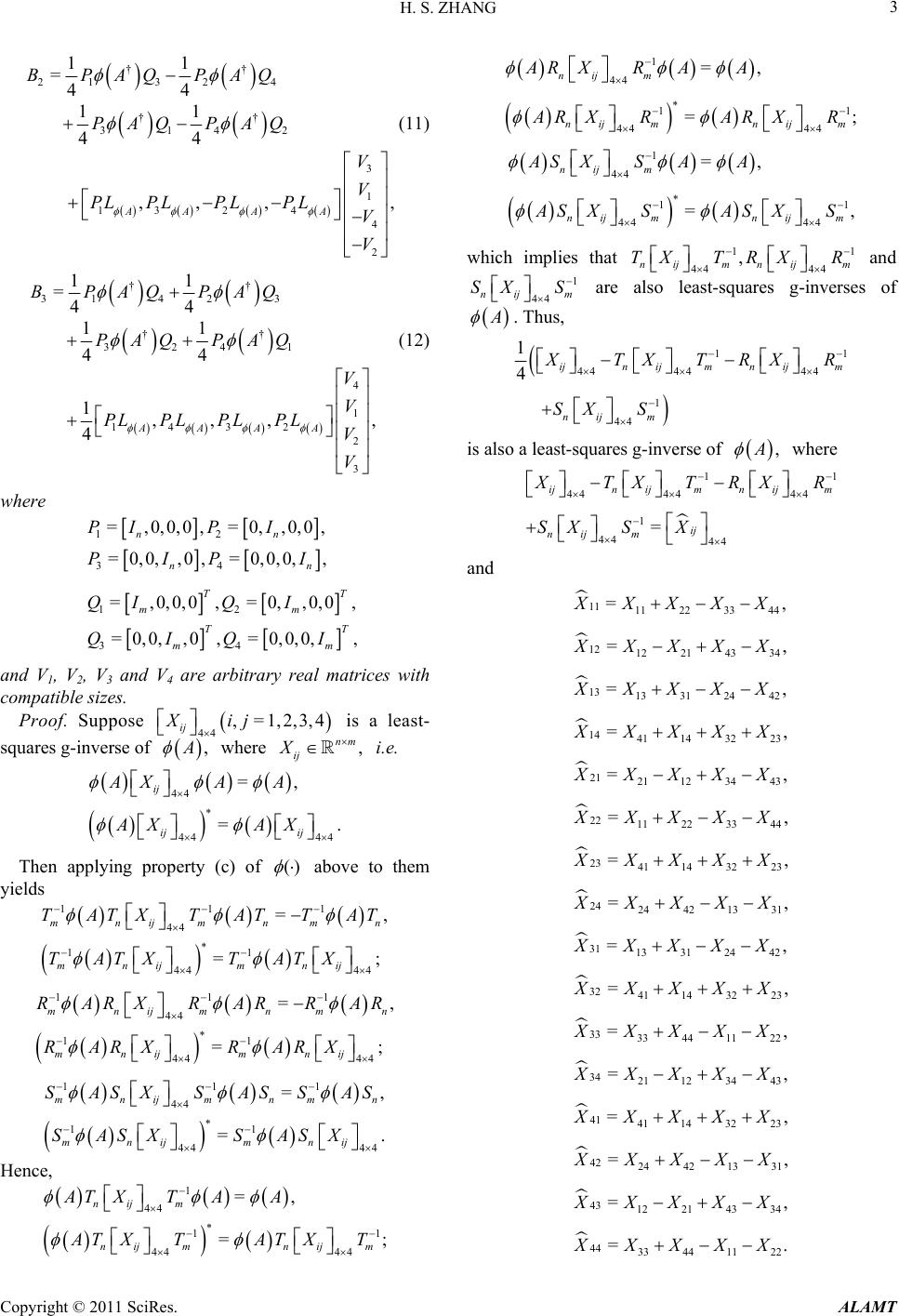 H. S. ZHANG 3 †† 21 324 †† 3142 3 1 13 2 44 2 11 =44 11 44 ,,,, AA AA BPAQPAQ PAQ PAQ V V PLPL PL PLV V (11) †† 31 42 3 †† 3241 4 1 1432 2 3 11 =44 11 44 1 ,,,, 4AAAA BPAQPAQ PAQ PAQ V V PL PL PL PLV V (12) where 12 34 =,0,0,0 ,=0,,0,0 , =0,0,,0,=0,0,0,, nn nn PIP I PIP I 12 34 =,0,0,0 ,=0,,0,0 , = 0,0,,0,=0,0,0,, TT mm TT mm QIQ I QIQ I and V1, V2, V3 and V4 are arbitrary real matrices with compatible sizes. Proof. Suppose 44 , =1,2,3,4 ij Xij , is a least- squares g-inverse of X where i.e. , nm ij 44 44 44 =, =. ij ij ij AXAA AX AX Then applying property (c) of () above to them yields 111 44 11 44 44 =, =; mnijmnm mnij mnij TATXTATTAT TATXTATX n 111 44 11 44 44 =, =; mnijmnmn mnij mnij RARXRAR RAR RARX RARX 111 44 11 44 44 =, =. mnijmnmn mnij mnij SASXSASSAS S ASXS ASX Hence, 1 44 11 44 44 =, =; nij m nij mnij m AT XTAA TX TATX T 1 44 11 44 44 =, =; nij m nij mnij m AR XRAA RX RARX R 1 44 11 44 44 =, =, nij m nij mnij m AS XSAA SX SASX S which implies that and 11 44 44 , nij mnijm TXT RXR 1 44 nij m SXS are also least-squares g-inverses of . Thus, 11 44 4444 1 44 1 4 ijnijm nijm nij m TXT RXR SX S is also a least-squares g-inverse of , where 11 44 4444 1 44 44 = ijnijmnijm ij nij m TXTRXR SX SX and 11 11 22 33 44 12 12 21 43 34 13 13 3124 42 14 41 143223 21 2112 34 43 22 11 22 33 44 23 41 143223 24 24421331 31 13 31 2442 32 41 143223 =, =, =, =, =, =, =, =, =, =, XXXXX XXXX X XXXX XXXX XXXX XXXX XXXX XXXX XXXXX XXXX 33 3344 11 22 34 21123443 41 41 143223 42 24421331 43 12 21 43 34 44 3344 11 22 =, =, =, =, =, =. XXXX XXX X XXXX XXXX XXXX XXXX Copyright © 2011 SciRes. ALAMT 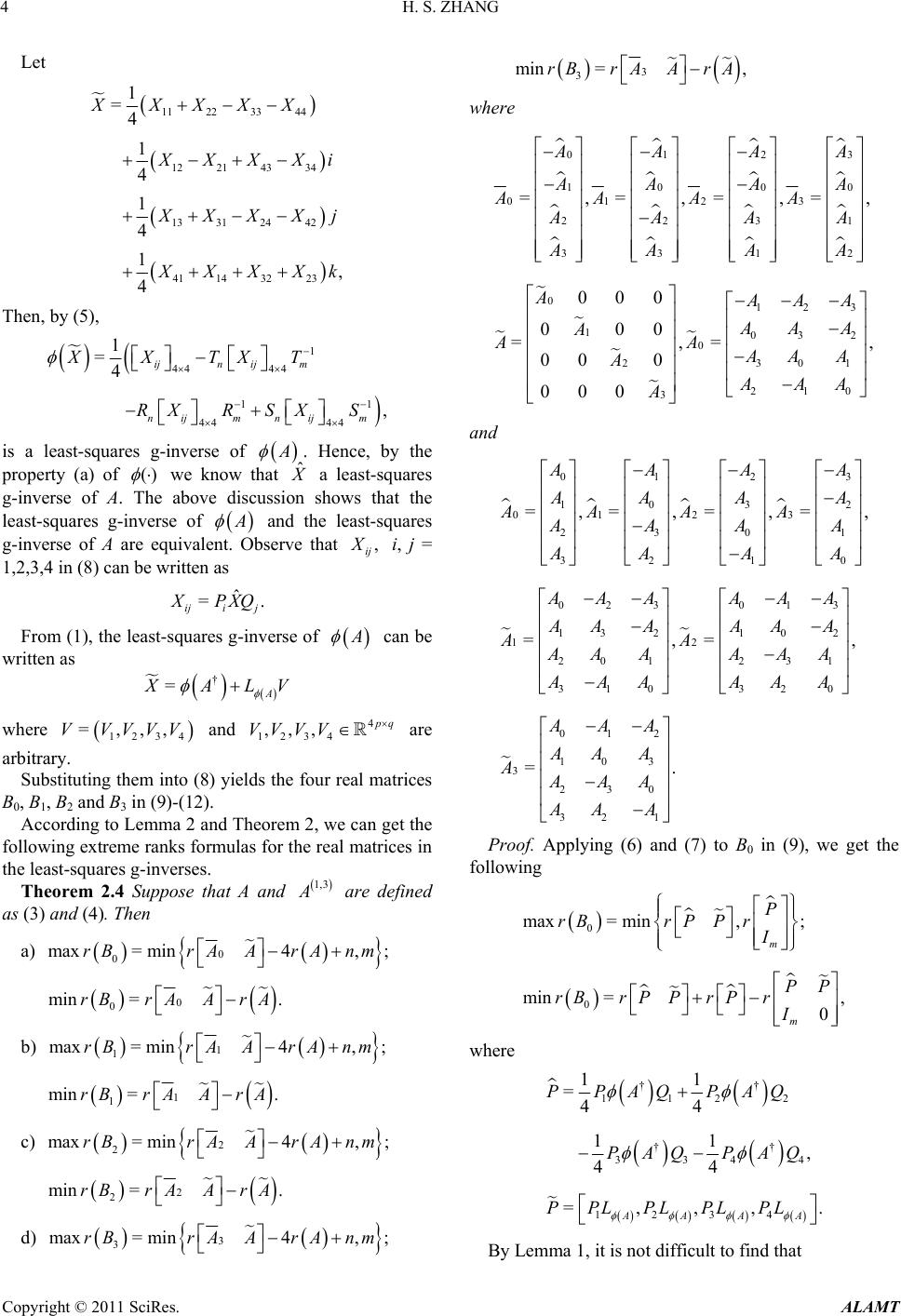 H. S. ZHANG 4 Let 11 22 33 44 12 21 43 34 1331 2442 41 143223 1 =4 1 4 1 4 1 , 4 XXXXX XXXi XXXj XXXk Then, by (5), 1 44 44 11 44 44 1 =4 , ijnijm nijm nijm XXTXT RXR SXS is a least-squares g-inverse of . Hence, by the property (a) of () we know that ˆ a least-squares g-inverse of A. The above discussion shows that the least-squares g-inverse of and the least-squares g-inverse of A are equivalent. Observe that , ij i, j = 1,2,3,4 in (8) can be written as ˆ =. iji j PXQ From (1), the least-squares g-inverse of can be written as † =A ALV where and 1234 =,,,VVVVV 4 1234 ,,, q VVVV are arbitrary. Substituting them into (8) yields the four real matrices B0, B1, B2 and B3 in (9)-(12). According to Lemma 2 and Theorem 2, we can get the following extreme ranks formulas for the real matrices in the least-squares g-inverses. Theorem 2.4 Suppose that A and 1,3 are defined as (3) and (4). Then a) 0 0 max=min4,;rBrAArA nm 0 0 min =.rBrAA rA b) 1 1 max= min4,;rBrAArA nm 1 1 min =.rBrA A rA c) 2 2 max= min4,;rBrAArA nm 2 2 min =.rBrAA rA d) 3 3 max=min4,;rBrAArAnm 3 3 min =,rBrAArA where 01 2 10 0 0123 223 33 1 0123 103 2 0 230 1 210 3 =,=,=,= 000 000 =,= 00 0 000 AAA AA AA AAAA AAA AAA A 3 0 1 2 , A A A AA AA A AA AA A AAAA A , , , and 03 12 12 03 01 23 2130 3021 023 013 13 2102 12 20 12 31 310 320 01 3 =,= ,= ,= =,= = A AA A AA AA AA AA AA AA AA AAA AAA AA AAA A AA AAAA AA AAA AAA AAA A 2 103 230 32 1 . AA A AAA AA A Proof. Applying (6) and (7) to B0 in (9), we get the following 0 0 max= min,; min =, 0 m m P rBrPP rI PP rBrP PrPrI where †† 112 2 †† 334 1234 11 =44 11 , 44 =,,, AAAA PPAQPAQ PAQPAQ PPLPLPLPL 4 . By Lemma 1, it is not difficult to find that Copyright © 2011 SciRes. ALAMT 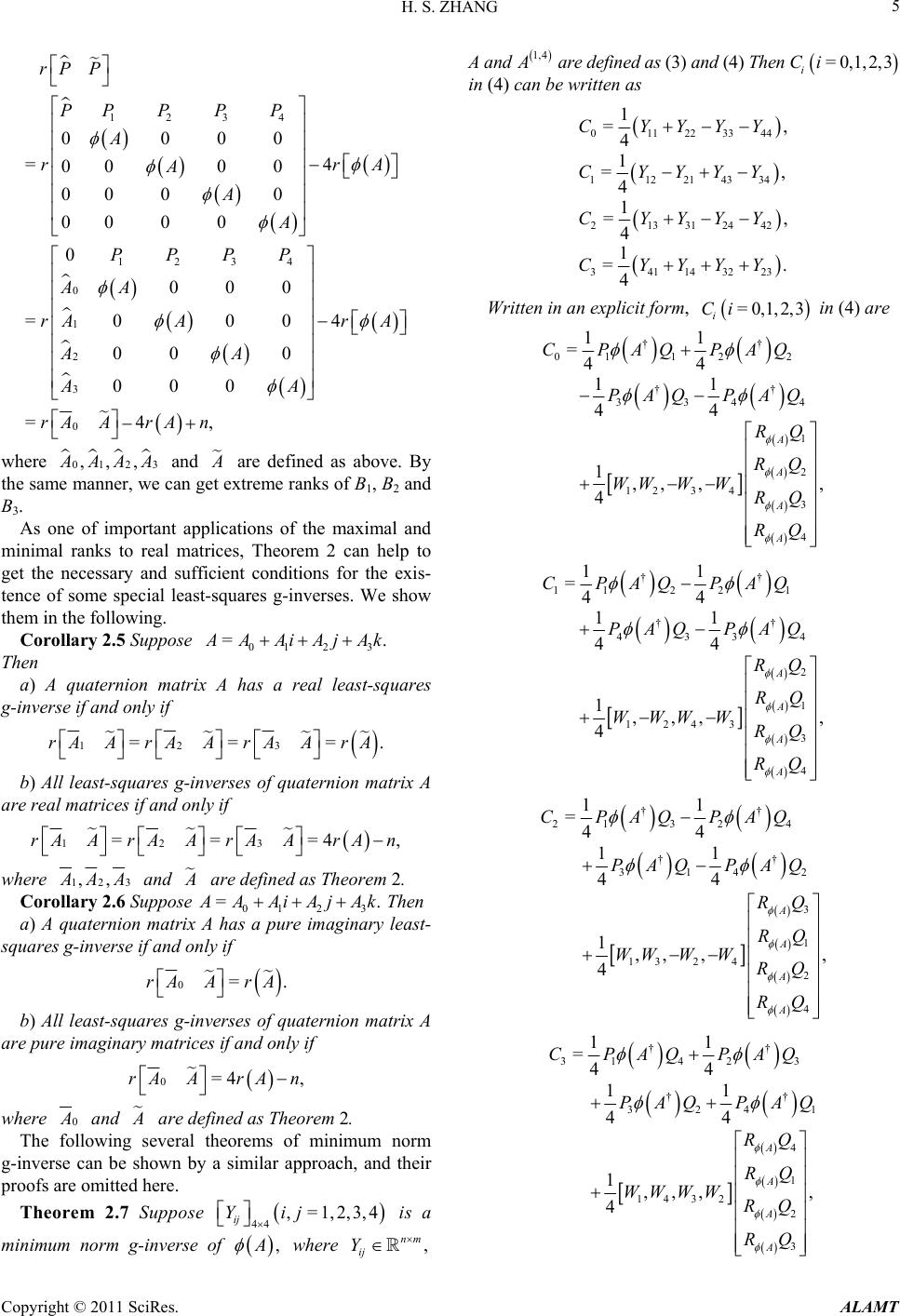 H. S. ZHANG 5 1234 1234 0 1 2 3 0 0000 =4 000 0 00 00 00 0 0 0 000 000 =4 00 0 000 =4, rP P PP PPP A rrA A A A A PPPP AA AA rr AA AA rAArA n where 0123 ,,, AAA and are defined as above. By the same manner, we can get extreme ranks of B1, B2 and B3. As one of important applications of the maximal and minimal ranks to real matrices, Theorem 2 can help to get the necessary and sufficient conditions for the exis- tence of some special least-squares g-inverses. We show them in the following. Corollary 2.5 Suppose 0123 =. AAiAjAk Then a) A quaternion matrix A has a real least-squares g-inverse if and only if 123 ===rAArAArAArA . b) All least-squares g-inverses of quaternion matrix A are real matrices if and only if 123 ===4rAArAArAArA n , where 123 ,, AA and are def i ned as Theorem 2. Corollary 2.6 Suppose 01 23 =. AAiAjAk Then a) A quaternion matrix A has a pure imaginary least- squares g-inverse if an d only if 0=.rA ArA b) All least-squares g-inverses of quaternion matrix A are pure imaginary matrices if and only if 0=4 ,rAArA n where 0 and are def i ned as Theorem 2. The following several theorems of minimum norm g-inverse can be shown by a similar approach, and their proofs are omi tte d he re. Theorem 2.7 Suppose is a 44 , =1,2,3,4 ij Yij minimum norm g-inverse of , where A and , nm ij Y 1,4 are defined as (3) and (4) Then in (4) can be written as =0,1,2,3 i Ci 0 11223344 34 42 23 1122143 2133124 3411432 1 =, 4 1 =, 4 1 =, 4 1 =. 4 CYYYY CYYYY CYYYY CYYYY Written in an explicit form, =0,1, i Ci 2,3 in (4) are 2 4 1 2 3 4 , Q Q RQ RQ RQ RQ †† 01 12 †† 334 1234 11 =44 11 44 1 ,,, 4 A A A A CPAQPA PAQPA WWW W 1 34 2 1 3 4 , Q Q RQ RQ RQ RQ †† 11 22 †† 43 1243 11 =44 11 44 1 ,,, 4 A A A A CPAQPA PAQ PA WWWW 4 2 3 1 2 4 , A A A A Q Q RQ RQ RQ RQ †† 21 32 †† 314 13 24 11 =44 11 44 1 ,,, 4 CPAQPA PA Q PA WW W W †† 31 42 324 14 32 11 =44 11 44 1 ,,, 4 A A A A CPAQPA PAQ P RQ RQ WWWW RQ RQ 3 †† 1 4 1 2 3 , Q AQ Copyright © 2011 SciRes. ALAMT 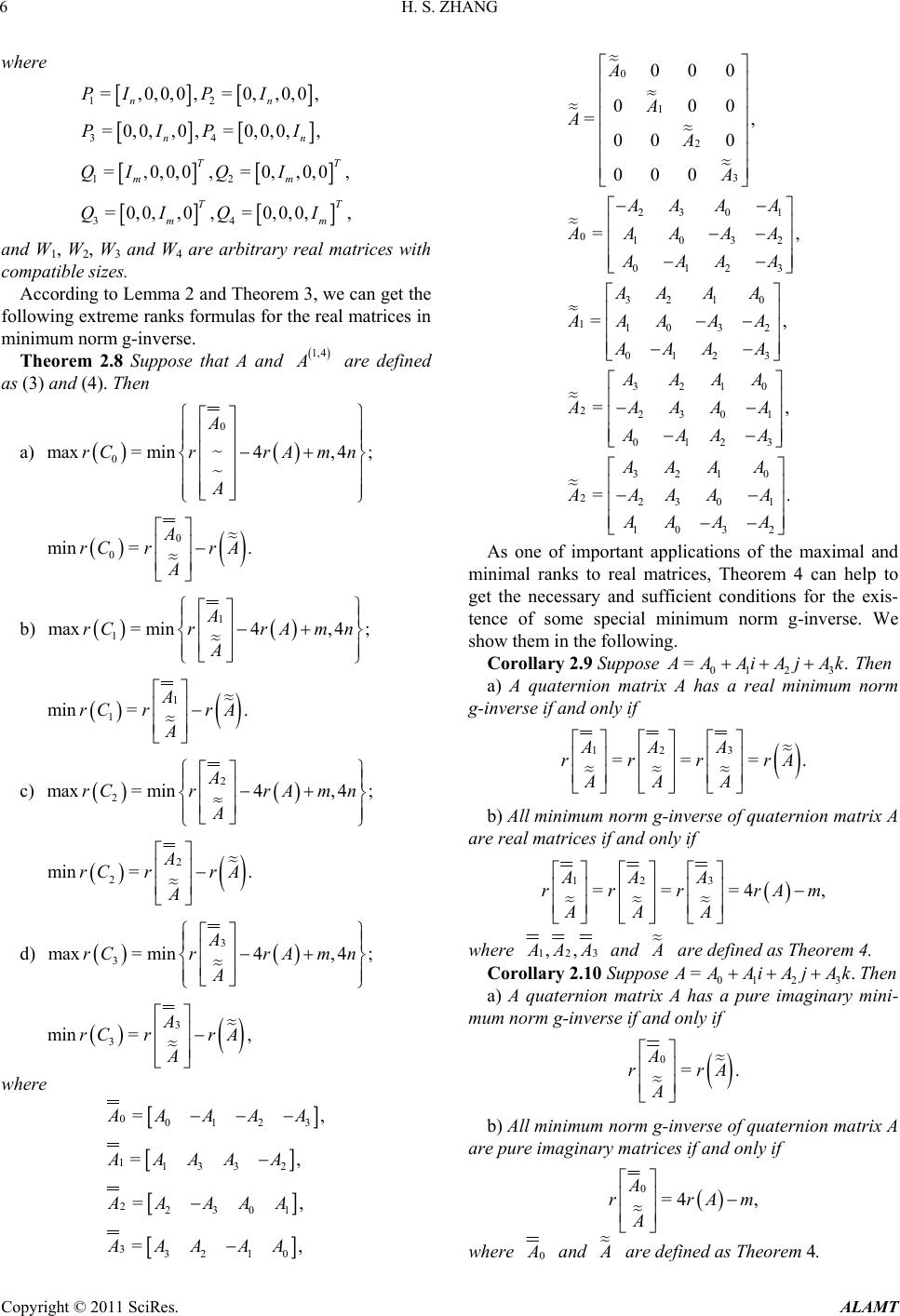 H. S. ZHANG 6 where 12 34 12 34 =,0,0,0 ,=0,,0,0 , = 0,0,,0,= 0,0,0,, =,0,0,0 ,=0,,0,0 , = 0,0,,0,= 0,0,0,, nn nn TT mm TT mm PIP I PIP I QIQ I QIQ I and W1, W2, W3 and W4 are arbitrary real matrices with compatible sizes. According to Lemma 2 and Theorem 3, we can get the following extreme ranks formulas for the real matrices in minimum norm g-inverse. Theorem 2.8 Suppose that A and 1,4 are defined as (3) and (4). Then a) 0 0 max= min4,4; A rCrrAm n A 0 0 min =. A rC rrA A b) 1 1 max= min4,4; A rCrrAmn A 1 1 min =. A rC rrA A c) 2 2 max= min4,4; A rCrrAmn A 2 2 min =. A rC rrA A d) 3 3 max=min4,4; A rCrrAm n A 3 3 min =, A rC rrA A where 0012 3 1133 2 22301 33210 = =, =, =, 0 1 2 3 23 01 010 32 0123 32 10 1103 2 0123 3210 2230 1 0123 321 0 223 01 1032 000 000 =, 000 000 =, =, =, = A A AA A AA A AA AA AA A AAA A AAAAA AAA A AAAA AAAAA AAAA AAAA AAAAA AA A A . As one of important applications of the maximal and minimal ranks to real matrices, Theorem 4 can help to get the necessary and sufficient conditions for the exis- tence of some special minimum norm g-inverse. We show them in the following. Corollary 2.9 Suppose 01 23 =. AAiAjAk Then a) A quaternion matrix A has a real minimum norm g-inverse if and only if 123 === AAA rrrr AAA .A b) All minimum norm g-inverse of quaternion matrix A are real matrices if and only if 123 ===4 AAA rrr rA AAA ,m where 123 ,, AA and are def i ned as Theorem 4. Corollary 2.10 Suppose 01 23 =. AAiAjAk Then a) A quaternion matrix A has a pure imaginary mini- mum norm g-inverse if and only if 0=. A rr A A , AAAA AAAAA AAAAA AAAAA b) All minimum norm g-inverse of quaternion matrix A are pure imaginary matrices if and only if 0=4, A rrA A m where 0 and are define d as Theorem 4. Copyright © 2011 SciRes. ALAMT 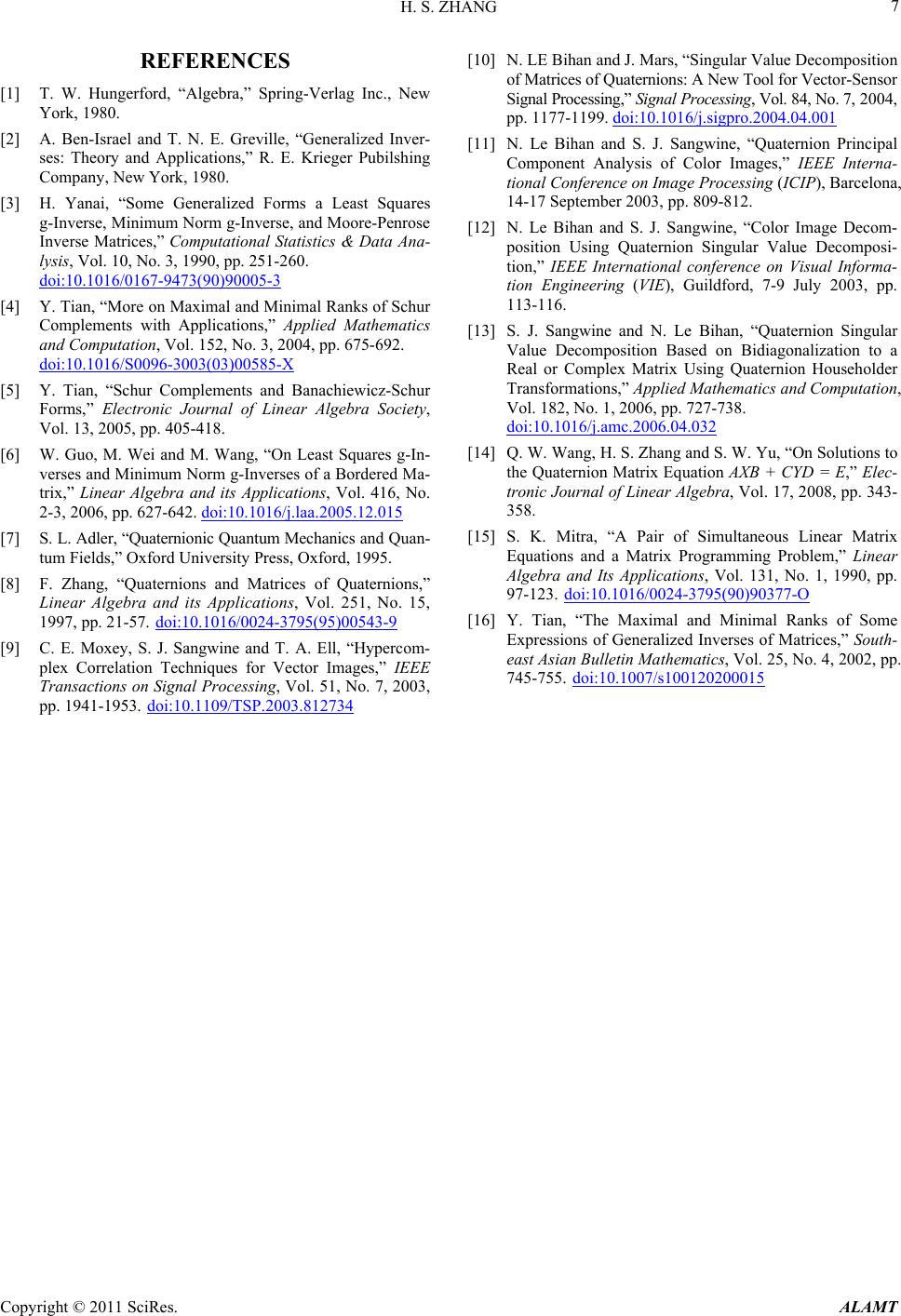 H. S. ZHANG Copyright © 2011 SciRes. ALAMT 7 REFERENCES [1] T. W. Hungerford, “Algebra,” Spring-Verlag Inc., New York, 1980. [2] A. Ben-Israel and T. N. E. Greville, “Generalized Inver- ses: Theory and Applications,” R. E. Krieger Pubilshing Company, New York, 1980. [3] H. Yanai, “Some Generalized Forms a Least Squares g-Inverse, Minimum Norm g-Inverse, and Moore-Penrose Inverse Matrices,” Computational Statistics & Data Ana- lysis, Vol. 10, No. 3, 1990, pp. 251-260. doi:10.1016/0167-9473(90)90005-3 [4] Y. Tian, “More on Maximal and Minimal Ranks of Schur Complements with Applications,” Applied Mathematics and Computation, Vol. 152, No. 3, 2004, pp. 675-692. doi:10.1016/S0096-3003(03)00585-X [5] Y. Tian, “Schur Complements and Banachiewicz-Schur Forms,” Electronic Journal of Linear Algebra Society, Vol. 13, 2005, pp. 405-418. [6] W. Guo, M. Wei and M. Wang, “On Least Squares g-In- verses and Minimum Norm g-Inverses of a Bordered Ma- trix,” Linear Algebra and its Applications, Vol. 416, No. 2-3, 2006, pp. 627-642. doi:10.1016/j.laa.2005.12.015 [7] S. L. Adler, “Quaternionic Quantum Mechanics and Q uan - tum Fields,” Oxford University Press, Oxford, 1995. [8] F. Zhang, “Quaternions and Matrices of Quaternions,” Linear Algebra and its Applications, Vol. 251, No. 15, 1997, pp. 21-57. doi:10.1016/0024-3795(95)00543-9 [9] C. E. Moxey, S. J. Sangwine and T. A. Ell, “Hypercom- plex Correlation Techniques for Vector Images,” IEEE Transactions on Signal Processing, Vol. 51, No. 7, 2003, pp. 1941-1953. doi:10.1109/TSP.2003.812734 [10] N. LE Bihan and J. Mars, “Singular Value Decomposition of Matrices of Quaternions: A New Tool for Vector-Sensor Signal Processing,” Signal Processing, Vol. 84, No. 7, 2004, pp. 1177-1199. doi:10.1016/j.sigpro.2004.04.001 [11] N. Le Bihan and S. J. Sangwine, “Quaternion Principal Component Analysis of Color Images,” IEEE Interna- tional Conference on Image Processing (ICIP), Barcelona, 14-17 September 2003, pp. 809-812. [12] N. Le Bihan and S. J. Sangwine, “Color Image Decom- position Using Quaternion Singular Value Decomposi- tion,” IEEE International conference on Visual Informa- tion Engineering (VIE), Guildford, 7-9 July 2003, pp. 113-116. [13] S. J. Sangwine and N. Le Bihan, “Quaternion Singular Value Decomposition Based on Bidiagonalization to a Real or Complex Matrix Using Quaternion Householder Transformations,” Applied Mathematics and Computation, Vol. 182, No. 1, 2006, pp. 727-738. doi:10.1016/j.amc.2006.04.032 [14] Q. W. Wang, H. S. Zhang and S. W. Yu, “On Solutions to the Quaternion Matrix Equation AXB + CYD = E,” Elec- tronic Journal of Linear Algebra, Vol. 17, 2008, pp. 343- 358. [15] S. K. Mitra, “A Pair of Simultaneous Linear Matrix Equations and a Matrix Programming Problem,” Linear Algebra and Its Applications, Vol. 131, No. 1, 1990, pp. 97-123. doi:10.1016/0024-3795(90)90377-O [16] Y. Tian, “The Maximal and Minimal Ranks of Some Expressions of Generalized Inverses of Matrices,” South- east Asian Bulletin Mathematics, Vol. 25, No. 4, 2002, pp. 745-755. doi:10.1007/s100120200015
|